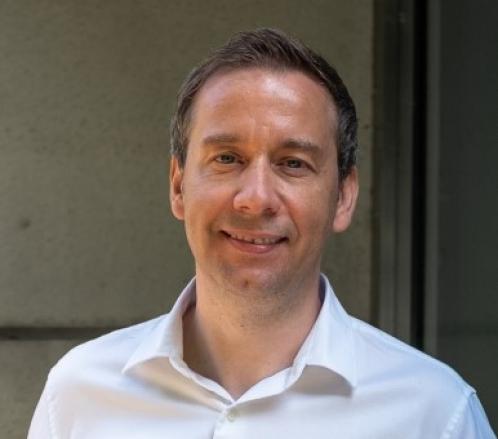Prof. Dr Dominik Mahr is excited about the unprecedented possibilities AI offers individuals and companies. “All students are now using ChatGPT or a similar tool, and so do I. In the car on the way to work, for instance, I engage in conversation with a chatbot. In fact, I did so in preparation for this interview. What questions can I expect? What do I want to say? It motivates and brings the topic to life. This way, I start my day inspired and well-prepared.”
Prof. Dr Dominik Mahr is a professor in Digital Innovation & Marketing and Scientific Director at UMIO/Innovate. His Maastricht University profile lists an impressive number of areas of expertise, such as innovation, marketing, digitisation, strategy, services and design thinking. He co-founded the Digital Experience Lab (DEXLab) at the School of Business and Economics, an innovation playground for researchers, teachers and students to experiment with digital experiences. A special area of expertise is service robots, where he took the initiative with other researchers to set up the Maastricht Center for Robots (MCR). Dominik is especially interested in the human side of digitalisation. He combines teaching and state-of-the-art research with practical experience and acts as the linking pin between UMIO/Innovate and companies.
From industry to academia
Dominik started his career in the automotive industry. After a few years, he decided he wanted to work in academia. “What appeals to me is that I can pursue research topics that are relevant to society and that interest me. This job allows me to address current (business) challenges and find solutions based on academic knowledge and insights. I enjoy working with students at various levels, including bachelor’s, MBA and PhD candidates. It’s my passion to support them in developing critical thinking, entrepreneurial skills and problem-solving skills. It is rewarding and a lot of fun.”
Companies’ struggles: using AI
As Scientific Director of UMIO/Innovate, Dominik Mahr experiences up close with what companies struggle. “At UMIO/Innovate, we help large and small companies innovate. I think the biggest struggle is that organisations feel they have to ‘do something’ with AI and digital technology and, at the same time, have no idea what that could entail. They think of it as very big and comprehensive. But it comes down to creating a specific use case for the company that is appropriate to the question or problem, the type of organisation, the product, or the production process. This doesn’t have to be big at all. For example, consider a marketer creating LinkedIn campaigns using AI.”
SMEs and university
Dominik notes that SMEs find it difficult to find their way to the university. “The university is big, and sometimes, they don’t know where to go or what to ask for. They also think the knowledge is too abstract to apply directly. Fortunately, we work well with regional organisations like Brightlands or LIOF. They know many regional companies and have a good sense of what they need. We decided to make clusters of SMEs and work with them in a format that suits them. Think of specific master classes and working on real-life projects. This is how we bring solid knowledge through co-creation with students. We did this in the fields of 3D printing, AI, Virtual Reality, and robots, among others. It’s great to see that companies value these sessions. Not only do they go home with applicable learnings, but they also get to know each other. Another positive effect is that these companies present themselves to the students. These are sometimes amazed at what cool things happen in regional SMEs and realise they could have a career there.”
A hackathon to improve communication
“At UMIO/Innovate, we co-create with the company, working step by step through each phase of a project using the Design Thinking Method. The project can be any innovation, such as the adaptation of a production line, the development of a new product, or a development for a particular customer. A current example is APG. This pension fund wants to improve its communication with young people. We organised a two-day hackathon with 130 students in the Marketing Strategy & Innovation course. Before, they worked in 44 innovation teams on the topic for 6 weeks. After briefing the students and supplying them with creative thinking methods and other useful tools, they got to work. They delved into the subject, gathered trends, and received more information from APG. On the day of the hackathon, they co-created dozens of original ideas and developed business prototypes in collaboration with APG’s people. After further refinement, feedback and validation, the best concepts were selected the week after through voting. During the finale, the students pitched to representatives of APG. It was great fun, very inspiring and dynamic.” Dominik understands why APG wants to work with UMIO/Innovate. “The knife cuts several ways. APG engages directly with the target group, allowing them to get to know it very well. The very diverse and original solutions that the students come up with match the target groups. Moreover, this approach is a way to engage with future colleagues. For UMIO/Innovate, this is a great way to connect with a great employer and make a positive impact in the region through our research and education.”
Humans first
Although Dominik is excited about digital innovation, he also focuses on the negative sides. “Ultimately, it’s always about finding the balance between the benefits and risks. What’s most important is that it’s not about technical innovation, but it’s about coming up with solutions that put humans first, focusing on actions that humans don’t want to do anymore or that a machine simply does better and/or faster. If we keep that in mind, I am positive that we can help every company to benefit from digital progress.”
UMIO/Innovate, UMIO’s innovation unit, assists people in creating the right solutions to propel themselves, their team, or their organisation forward into a more sustainable future. Click here to learn more about UMIO/Innovate.



